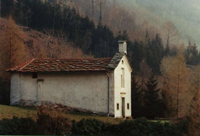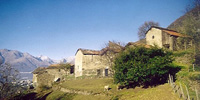History
The first settlements in Dorio date back to long ago. The Celtic presence is shown in the domed structured masses, the most important of them being those of Comballo. With respect to the name of Dorio, not all of the versions agree. Some believe that the name derives from the fact that the sun, reaching the sunset, shines through the mountains with reflects that seem pure golden, or "dorato" in Italian. A more plausible hypothesis attributes instead the name to Greek origin. It seems that in the year 59 AD Julius Ceaser had invited 500 noble colonist from Greater Greece to repopulate the shores of Lario. Carlo Andreani writes in "La Pieve di Dervio" printed in 1898: "One tradition celebrates how the people in the beginning went to Mondonico, as was read from an old document, where they found a dozen houses.  The best position, the closest to the lake, or perhaps the rapid increase in the population, pushed some inhabitants to form a new center that slowly absorbed those of the original one. In the second half of the 15th century Dorio ceased to be part of Dervio (the neighboring town), and became a entity onto itself with its own administration. If one reads a document recovered from the parochial archives: "The autocratic character of the population of Dorio has made that it indeed has become a comune. This was no more than the beginning, the independence had to be complete".
The best position, the closest to the lake, or perhaps the rapid increase in the population, pushed some inhabitants to form a new center that slowly absorbed those of the original one. In the second half of the 15th century Dorio ceased to be part of Dervio (the neighboring town), and became a entity onto itself with its own administration. If one reads a document recovered from the parochial archives: "The autocratic character of the population of Dorio has made that it indeed has become a comune. This was no more than the beginning, the independence had to be complete".
In fact the building of the parish followed. The ancient small church of S. Giorgio di Mondonico that represents one of the assets of highest artistic value in Dorio, was for many years the parochial one for the town. For various reasons the mayor and people of Dorio requested of the Archbishop of Milan their own priest.
On May 26th 1506 the archbishop Ippolito I d'Este, cardinal of Ferrara, designated with an official act the Dorio community as a parish.
In 1542 Dorio became independent from Pieve di Dervio, but continued to belong to the big Milan diocese.
After various vicissitudes including repeated attacks and pillages of adventurers and of neighboring towns, finally in 1627 the Lansquenets invaded the area, thus introducing the terrible bubonic plague, which has become so well-known thanks to Alessandro Manzoni novel "I Promessi Sposi". This deadly plague brought the number of inhabitants of Dorio from 300 to 84 (36 families).
The population gradually increased, until in 1856 there were 347 inhabitants and in 1897 the number grew to 531 (85 families).
 The Dorio township included four lands or "villas": Mondonico, Panico, Torchiedo and Solmogno. The last one started in 1640-50 to be referred as Dorio, due to its greater development and its favorable location on the main communication road between Colico and Dervio.
The Dorio township included four lands or "villas": Mondonico, Panico, Torchiedo and Solmogno. The last one started in 1640-50 to be referred as Dorio, due to its greater development and its favorable location on the main communication road between Colico and Dervio.
 In 1676 a new church dedicated to the Holy Mary was open; it was later on enlarged, eventually demolished and restored in 1859.
In 1676 a new church dedicated to the Holy Mary was open; it was later on enlarged, eventually demolished and restored in 1859.
It was afterward dedicated to St. George.
The St. George Oratory, probably dating back to 14th Century, was restored in 1677 and in 1804. It is now possible to admire some recently restored frescos of 1492: in the upper part there is St. George and the Virgin Mary with the Holy Child; then St. Michael, two Bishops and again the Holy Mary. There was originally another picture of the Holy Mary, which was eventually taken and is now in the parish church.
In 1848, on the way to the Dorio mountains (the "wayfarer path", a very ancient road on the eastern shore of the Como Lake, between Lecco and Piantedo, which can still be traveled over) the small St. Rocco Church was built, about 443 mts. above the sea level. In 1928 the Dorio district joined Dervio, but then was again independent in 1948.
